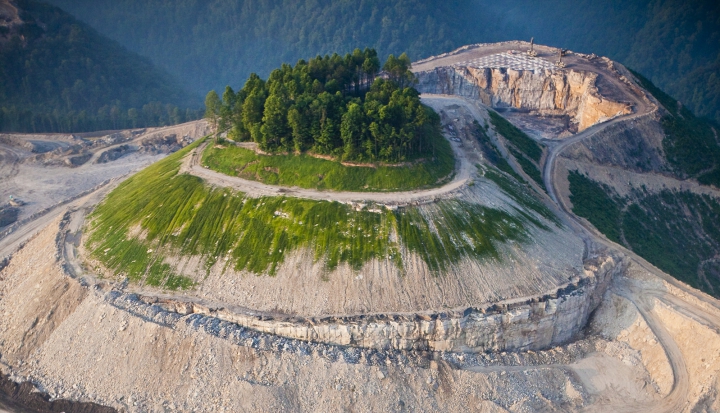In Appalachia, the coal industry thrives on stripping the landscape—and people’s livelihoods.
[Watch the slideshow that accompanies this article.]
Rick Handshoe lives on the battle line. Explosions shake his house regularly, covering it with dust and debris and cracking its foundation. A convoy of supply trucks rumbles constantly past his front porch. He lives amid danger and disturbance, with peace but a distant memory.
This war zone is not Iraq or Afghanistan but the once-quiet Appalachian mountains of rural eastern Kentucky. In order to extract cheap energy, the coal industry has waged a decades-long war on the Appalachian landscape and its people. Thus far, energy companies have been winning. “They’re destroying the mountains,” says Handshoe—ancient mountains that took hundreds of millions of years to form, destroyed quickly by human machinery. But though Handshoe and many like him are tired, angry, and outgunned, they are fighting back.
A rugged region stretching from lower New York to northern Georgia and Alabama, Appalachia sits atop vast quantities of high-quality coal. In recent decades the coal industry has begun to extract this coal by blowing off mountaintops to expose coal seams hundreds of feet below. Where native hardwood forests once stood—one of the most biologically diverse ecosystems in the temperate world—behemoth dragline excavators scrape away the coal amid a dusty, sterile moonscape of rock and rubble.
Decapitating a mountain produces so much debris (called “spoil” or “overburden”) that the material can rarely be replaced in the original contour. Instead, bulldozers shove it into nearby valleys. Where mountain streams once began in the uppermost folds of the mountains, valley fills now sit instead: huge, steep-walled dams of rock, often seeping water laden with toxic chemicals and heavy metals. When mining concludes, the broad plateau that remains is spread with a thin layer of soil, planted with trees or non-native grasses, and pronounced reclaimed.
Hard bargain
Mountaintop removal produces coal with 10 to 25 percent less expense than underground mining. Coal mined in this way seems cheap, however, only if “you think that people’s lives are cheap,” says Erica Urias, a resident of Pike County, Kentucky. Suspecting that nearby mines were affecting her water supply, Urias had the water tested and discovered that she had been bathing her young daughter in water that far exceeded acceptable levels of arsenic. “My baby girl is paying for coal with her childhood and health,” she says, “and to me that’s not cheap at all.”
Denise and Calvin Howard, also of Pike County, face a similar problem. Mountaintop removal often disturbs underground methane, and their well became so saturated with the flammable gas that it exploded. The well casing was still shooting flames months after the explosion.
Excel Mining, which operated the nearby mine, refused to address the problem adequately unless the Howards signed a liability release waiver. Only after a legal ruling did the company begin to deliver bottled water for cooking and drinking; the Howards have to bathe and do laundry elsewhere. With so much methane dissolved in the water, showering or washing dishes could cause an explosion.
The toll of mountaintop removal mining was even more tragic for the Davidson family in Wise County, Virginia. At 2:30 a.m. on Aug. 20, 2004, a 1,000-pound boulder, loosened by earthmoving equipment at the mine site above, rolled 649 feet down the mountain and through the wall of the Davidson family home, crushing 3-year-old Jeremy Davidson to death in his sleep.
Even those who do not die in such tragic accidents tend to die sooner and have poorer health. Peer-reviewed studies conducted by researchers at West Virginia University and Washington State University indicate that cancer rates doubled near mountaintop removal mines, and birth defects increased 26 percent. “This significantly higher risk was found after control for age, sex, smoking, occupational exposure, and family cancer history,” says researcher Dr. Michael Hendryx. The results of these studies add “to the growing evidence that mountaintop mining environments are harmful to human health.”
Social disease
Beyond its impacts on the lives and health of individual families, mountaintop removal mining unravels the very social fabric of Appalachian communities. Handshoe, of Floyd County, Kentucky, has discovered that even front porches, those long-standing bastions of neighborliness, become unusable because of the dust and noise from coal trucks barreling down mountain roads. Bitter, long-lasting feuds between families and neighbors often result when one party sells land to a mining company.
Social ills also stem from widespread poverty. Though coal companies tout the jobs they provide, they have actually cut mining jobs by more than half in the last 20 years as mountaintop removal methods replace human labor with earthmoving machinery. And counties whose economies are dominated by mining are among the poorest in the nation—leading to widespread drug problems, domestic violence, and underfunded education, health, and human services.
In the 2010 Gallup-Healthways Well-Being Index, coal-mining states Kentucky and West Virginia ranked 49th and 50th among all U.S. states. Of all 436 U.S. congressional districts, West Virginia District 03 and Kentucky District 05—the epicenters of mountaintop removal—ranked 432 and 435, respectively.
Those in poverty are often powerless before corporations. When International Coal Group mining operations bulldozed their way past the clear boundary markers of his land near Montgomery Creek, Kentucky, McKinley Sumner scraped the money together to retain legal counsel. Facing ICG’s army of attorneys, however, he has yet to receive any legal satisfaction.
“I am 74 years old, and I hike up to the ridgeline three times a week to make sure the company is not trying to come on my property again,” he says. “I just want them to know that I’m still here and I’m watching. I just don’t think that this should be happening in the United States.”
Fighting back
The struggle against mountaintop removal and the energy corporations that practice it may seem quixotic. Teri Blanton, a resident of Berea, Kentucky and an activist member of Kentuckians for the Commonwealth, puts it bluntly: “It’s not just about energy; it’s about power—corporate power. It’s all connected together: we’re fighting the railroads, because most of their freight is coal, we’re fighting the utility companies, and we’re fighting the coal companies.” And yet Blanton and other activists continue their dogged resistance, through demonstrations, legal procedures, raising awareness, and policing the often-lax enforcement of mining regulations.
The Catholic Church has joined Blanton, Handshoe, and others in protesting the destruction of the Appalachian mountains and culture. Drawing on principles of Catholic social thought, the 25 bishops of Appalachia issued the 1975 pastoral “This Land is Home to Me,” which celebrated the resilience and resourcefulness of the Appalachian people but lamented the injustices they so often suffer at the hands of corporate power.
Twenty years later, the Appalachian bishops issued another pastoral, “At Home in the Web of Life,” which attempted to envision Appalachian communities that were economically and ecologically sustainable. “The church needs to stand with those who live lives of hopelessness and helplessness,” wrote Walter Sullivan, bishop emeritus of Richmond, Virginia, after touring mountaintop removal mining sites and hearing the stories of Appalachian residents affected by the mining. “The mountain culture and its way life are being destroyed.”
Father John Rausch of the Glenmary Home Missioners is a prominent figure among the many Catholics battling against mountaintop removal. He has lived and ministered in Appalachia for more than three decades and currently serves as the director of the Catholic Committee of Appalachia, which fights for justice in Appalachia through education, networking, advocacy, publications, and public events. Armed with a degree in economics as well as theology, he has become known in the region as an expert analyst of issues related to mountaintop removal mining. “When you squeeze down all the corporate ideas of the efficiency and economics of this form of mining,” Rausch says, “they will drip blood.”
Rausch regularly leads mountaintop removal “witness tours” and public demonstrations such as the Cross in the Mountains prayer vigil (a video is on YouTube). When floods from a denuded mountain inundated a nearby town, he led a large group on a march through the flood’s aftermath. Armed only with flats of petunias, the marchers stopped to plant the flowers at homes and businesses where floodwaters had damaged and destroyed property. “We were replacing ugliness with beauty,” reflects Rausch, “despair with resurrection and hope.”
Rausch says he’s kept at this difficult work for so long by focusing on his ministry. “I’m a missioner,” he says with quiet, determined passion. “My job is to hear the cries of the poor. My job is to hear what people are going through. We’ve got to respond to the struggles of people.” Though he likens Appalachian resistance to “mosquitoes and gadflies,” he is quick to point out that “mosquitoes can keep a big corporation up all night.”
A new future
If mountaintop removal mining can be stopped, what might a better future look like for Appalachia? Underground mining, though also rife with environmental problems, may provide a stopgap solution for energy and employment. Eventually, however, the coal will run out or the climate effects from burning it will become unbearable.
“There’s no such thing as clean coal,” says activist Blanton. “We all live on this earth, and there are no outsiders when it comes to climate change. We need to use less coal and transition to renewable energy, just as fast as we possibly can.”
Appalachia’s future economy can thrive, says Rausch, but it will have to do so in a way that seems quite humble by today’s standards of rapid and infinite economic growth. Appalachia’s residents need not and cannot attempt to leap from poverty to conspicuous consumption; they must aim for enough rather than excess. In this way Appalachia can become a model for the world of how to live within the limits of one’s place. Within those limits new forms of spiritual and social abundance can be found, even with modest use of energy and natural resources.
Catholics can also help bring about a brighter future for Appalachia and the world at large. As individuals, parishes, dioceses, and national organizations, Catholics can learn about issues connected to mountaintop removal mining and coal use in general. They can advocate for policy change from their elected officials. They can insist that their electric utilities refuse to source coal from mountaintop removal mines and, better yet, provide renewable-power alternatives to coal. They can support new sustainable economic developments that emerge in Appalachia and mitigation efforts for damages already incurred.
Finally and perhaps most importantly, Catholics can cut back, using less of the power and steel that makes coal mining necessary at all. This witness to gospel humility truly supports a new culture of life, in Appalachia and beyond.
This article appeared in the April 2012 issue of U.S. Catholic (Vol. 77, No. 4, pages 12-16).
Image: Paul Corbit Brown













Add comment